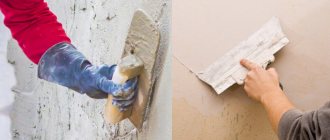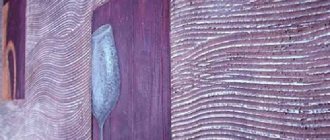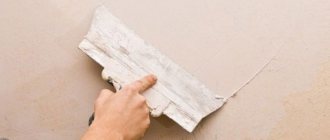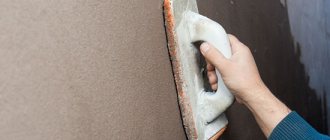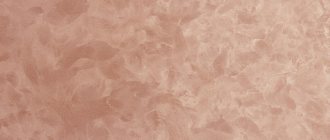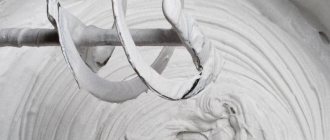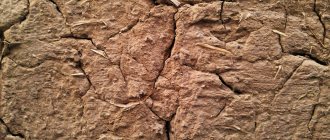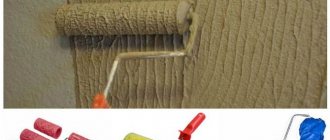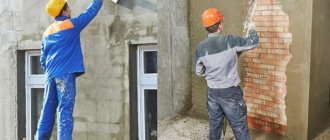Creating a pool bowl from concrete or brick material is not enough for its long-term operation; the pool needs to be plastered. The inner side will be constantly exposed to water pressure; the plastering finish will allow the base to be leveled in order to install a PVC film if necessary. The intricacies of choosing a material and working with it will be discussed in more detail below.
How to protect your pool from moisture
If you do not create a reliable barrier in the pool bowl without flaws, then over time the moisture will be able to reach the fittings, which from its influence will become covered with corrosive formations. During the cold season, the liquid that gets on the concrete or brick base will harden and the material will begin to collapse.
When a pool is built indoors, moisture will settle on other surfaces, for this reason it is necessary to create a water-repellent layer on the walls and ceiling.
There is always water in the pools, so condensation will also settle on the walls and other bases in the building. This is how waterproofing and moisture-resistant products are used to protect the premises and the pool.
If you do not create a reliable barrier in the pool bowl without flaws, then over time the moisture will be able to reach the fittings.
Why do you need wall plaster?
There are many materials for constructing the walls of a house. All of them form surfaces of varying degrees of evenness. But documents and standards establish the same requirements for the finished wall surface. For residential premises, the standard is a maximum unevenness of 1 mm per 1 meter of the wall surface. In order to obtain an even, smooth surface, the wall is plastered and then puttyed.
In order to check the evenness of the walls after plastering, they use a long rule that is used for plastering. The rule is applied to the wall in different positions - vertically, horizontally, diagonally, and they look at the gaps formed between the wall and the plane of the rule. If these gaps do not exceed the permissible values, this indicates high quality plastering.
Purpose of the plaster layer
Before plastering a pool with your own hands, you should understand what properties such a stage has. By plastering the surface of the bowl you can obtain the following protective functions:
- A base is created without unevenness, smooth, which can be covered with other finishing materials without difficulty;
- When the structure is installed outdoors, it is protected from the defrosting process, which helps avoid concrete cracking;
- Waterproofing plaster for the pool allows you to create a barrier so that water does not get to the iron fittings, and they do not begin to rust.
When the structure is installed outdoors, it is protected from the defrosting process, which helps to avoid cracking of the concrete.
Surface preparation
Before you begin finishing the concrete surface of the pool, you must carefully examine it. It is recommended that this procedure for examining the structure be entrusted to specialists. Especially if the structure was created not by your own hands, but by professionals.
It is important that the surface is smooth and that there are no cracks on it. With a thorough inspection of the walls, cracks can be identified independently. But in oval and round buildings it is very difficult to measure the evenness of the surface. Rectangular or square bowls are another matter: here it is much easier to determine the evenness of the walls.
The next stage is preparing the pool surface. The concrete base should be cleared of all debris and dust. Then treat it with a primer mixture, and be sure to penetrate deeply. It is able to penetrate deep into the concrete, resulting in a decrease in the material’s ability to absorb moisture.
Properties of waterproofing plasters
When water constantly impacts a structure, it not only destroys the material, but also puts pressure on the structure. For this reason, it is important to ensure a level base where there are no cracks through which moisture can penetrate further.
The following properties of hydro-resistant pool plaster can be distinguished:
- Creates waterproofing on the base;
- After applying the plaster, additional finishing materials can be used to protect and provide a decorative appearance. With the help of waterproof pool plaster, the base will become level;
- On other surfaces in the room where the pool is installed, water-repellent plasters are used; waterproof plasters are needed inside the bowl.
After applying the plaster, additional finishing materials can be used to protect and provide a decorative appearance.
No. 4. Pool bowl finishing options
Once the surface of the bowl is completely leveled, the most pleasant stage begins, during which the pool can be given the desired appearance. The range of materials for finishing a pool is quite wide, all of them meet the basic requirements for this type of finishing:
- resistance to moisture, the ability to retain its original properties during prolonged contact with water;
- hygiene, resistance to mold and fungi;
- ease of care;
- resistance to chemicals used to maintain the pool.
Suitable materials include ceramic tiles, mosaics and PVC film. Less commonly used are natural stone, liquid rubber, painting and sprayed polypropylene.
Is it possible to avoid the plastering step?
Pool plaster may not be used, but this option requires special skill from the master. After all, it is difficult to get an even pour of concrete. For this reason, such work technology is used extremely rarely, and the technique is usually performed only in small pools. The method saves the consumption of materials, but due to the difficulty of implementation, it is easy to obtain a low-quality result.
Pool plaster may not be used, but this option requires special skill from the master.
Pool waterproofing
Pool waterproofing
In addition to the external waterproofing of the concrete pool bowl (with roofing felt), it is also necessary to carry out internal waterproofing. To do this, it is recommended to use the following tips:
- To create a concrete pool bowl, use cement intended for the construction of hydraulic structures (grade NTs or GIDRO-S).
- Since we are dealing with a finished bowl, we can increase the waterproofing of the pool not only with water-repellent plaster, but also with special waterproofing substances that are applied to the surface of the bowl: Kalmatron, Penetrat, Hydrotex, Stromix, etc.
Types of plasters used
The plaster solution is selected separately for the bowl of the structure and for treating the walls of the room if the pool is located in the building. An important parameter is the cost of the trains, because the work to be done is extensive and the budget may suffer greatly.
Bowl binders typically use cementitious or synthetic material. The following types of plaster mixtures can be distinguished:
- Mineral based;
- Based on silicates;
- With acrylic;
- With silicone;
- Cement-polymer;
- Asphalt.
There is a division of material by area of application:
- For facade work;
- For indoor work;
- Universal.
There are different types according to the type of purpose:
- To obtain a smooth surface;
- Decorative;
- Special, to obtain certain properties.
The plaster solution is selected separately for the bowl of the structure and for treating the walls of the room if the pool is located in the building.
Waterproofing plasters
Waterproof types can be distinguished by the mechanics of the impact on the base. The following types are distinguished here:
- Hydrophobic, the principle of action involves repelling water;
- Waterproof.
Special types help achieve high density to provide a reliable barrier against water. The composition uses elements that can penetrate into the smallest pores, so the protection becomes the most reliable. Or compounds can be used that repel water from the surface.
Special types help achieve high density to provide a reliable barrier against water.
Moisture-resistant plaster for pool walls
To provide protection for the walls and ceiling of the room where the pool is installed, compounds are needed that repel water, while allowing air to pass freely through the layer of plaster. Cement types are used, which can be bought on the construction market or prepared with your own hands.
The product is selected based on the type of base:
- For concrete and brick, you can consider Azolit VSh;
- A universal option is Ceresit CP65;
- For stone and brick bases, an EC mixture is suitable.
You can get waterproof properties from a micro cement composition by creating a 3 mm layer.
To provide protection for the walls and ceiling of the room where the pool is installed, compounds are needed that repel water.
Homemade solution
You can make a protective plaster compound yourself, saving money. You don't need to purchase a lot of materials for this. An example would be the preparation of a composition using ceresite:
- Mix one part of the mixture with 10 parts of water;
- A mixture of cement and sand is added, the proportion can be 1 to 1 or 1 to 3;
- It is necessary to apply the solution to the surface within half an hour, after which the properties are lost.
Such a solution is applied with a thickness of at least 20 mm.
You can also resort to creating a solution from liquid glass:
- To one part of liquid glass add 10 parts of water;
- A cement-sand mixture is added.
The solution differs in its speed of setting, it is prepared in small portions, so it must be applied in 2-5 minutes. The option is able to reliably cover cracks where water can penetrate.
The solution differs in its speed of setting, it is prepared in small portions, so it must be applied in 2-5 minutes.
How to properly plaster a pool area
Due to difficult climatic conditions in our country, swimming pools are often built not in the open-air courtyard, but indoors. And finishing the inside of such premises very often involves plastering work, especially if it is necessary to level the walls. In this case, cement-based compositions intended for use in bathrooms and other wet areas are suitable.
Thus, walls can be treated with ceresit (Ceresit CR 65), which is a cement mixture intended for all types of stone foundations (brick, concrete). There are a lot of types of Ceresit plaster, like Knauf, and their detailed analysis is worthy of a separate article. If you want something with a decorative effect, you can use STUC DECO or STUC GRANITO products. These compositions have polymer binders, which allows them to be elastic. Naturally, the cost of such plaster is extremely high, and not everyone can afford such finishing.
Tools and accessories
Pool plastering technology involves preparing the necessary tools and materials, without which it will not be possible to apply the composition efficiently and evenly. The list includes the following devices:
- Trowel;
- Grater;
- Trowel and ladle;
- Brushes, rollers;
- Spatulas of different sizes;
- Rule for tracking layer evenness;
- Roulette and level;
- Containers for preparing the solution;
- Beacons;
- Construction mixer/drill with a special attachment;
- Plumb.
To ensure safety for the health of the master, PPE is used.
Plastering a pool involves preparing the necessary tools and materials.
Preparation of plaster mixture for the pool
It is necessary to prepare the solution only before starting to apply it to the surface; its period of use is not very long, it is prescribed on the packaging. The required volume of water is poured into a clean container, then the mixture is added. The components must be mixed thoroughly using a solution stirring device.
If you do the plaster yourself, then you start by mixing the dry substances, after which the liquid elements are dissolved in half the required volume of water, where you can add the dry additives mixed together.
Mixing elements must be observed in the proportions specified by the manufacturer. When adding water, look at the resulting solution so that it is convenient to apply. After mixing the components, wait 10-15 minutes for the solution to infuse. Then mix the solution again.
Mixing elements must be observed in the proportions specified by the manufacturer.
Stages of finishing walls in a room
- The surface is cleaned of uneven surfaces and, if necessary, cracks are repaired. All loose elements must be dismantled. The wall is cleaned of dirt, dust and grease stains;
- As a way to improve adhesion, the surface is primed;
- A leveling layer of plaster is applied. It is ideal to use a cement-based composition of the M150 brand. The layer depends on the parameters of the base. In the case of very uneven walls, it may be necessary to apply a thick layer along the beacons;
- After complete drying, final finishing is carried out, either with a moisture-resistant finishing layer, or rubber paint, or tile material.
How to plaster the pool walls and bowl floor using technology
When applying plaster to a concrete pool bowl, the main thing is to create a reliable fixation of the layer. There are two reliable methods for obtaining high-quality results; the process is regulated by SNIP:
- Plastering on a mesh. It stands out for its ease of creation, but if water seeps into the mesh, it will become covered with rust;
- Glue method. This method is more difficult to implement, but the result is durable and uniform.
When applying plaster to a concrete pool bowl, the main thing is to create a reliable fixation of the layer.
Manual application with reinforcement
The technique is distinguished by its simplicity, therefore it is often chosen by beginners, but if the technology is violated, the result will be spoiled. Follow the steps below:
- The surface is carefully prepared, all types of dirt and greasy stains are removed. In brick you need to deepen the seams by a centimeter, in concrete you need to make notches. Cracks are eliminated, protruding elements are also removed.
- A primer solution is applied to a clean and dry surface.
- A mesh is attached to the walls and bottom using dowels or anchors.
- Beacons are being installed.
- Prepare the plaster.
- Application is carried out by spray and primer. When the composition has set, the beacons are removed and the base is dried for 24 hours.
- Next, the base is primed, dried, and treated with a covering.
- The base is being rubbed.
A primer solution is applied to a clean and dry surface.
Plastering a pool bowl using shotcrete
The use of this technique gives high-quality results, but requires special equipment. The principle of operation of the equipment is to supply a solution to the surface through a special hole. After which the layer is securely fixed to the base. The elements necessary for plastering are mixed in a special compartment.
The use of this technique gives high-quality results, but requires special equipment.
Purpose of plaster in the pool
Plastering works help level the pool bowl.
The lack of high-quality protection for a concrete or brick bowl causes water to seep through small pores. Over time, the liquid will reach the fittings, causing corrosion and structural failure. In summer, water will saturate the layers of the structure, and in winter it will crack the foundation from the inside. The building in this condition will not last long.
Due to the fact that the walls and bottom of the pool are subject to constant contact with a wet environment, the surfaces must be protected. For these purposes, plaster mixtures of different compositions have been developed - waterproofing and waterproof.
Plastering complex surfaces
Dealing with uneven pool elements that may serve decorative or other practical purposes is difficult. It is inappropriate to describe the entire process as it is almost impossible for beginners to cope with the task. If the pool has similar features, then it is better to resort to the services of professionals to get a good result.
If the pool has similar features, then it is better to resort to the services of professionals.
Making hydrophobic plaster with your own hands
If the necessary components are available, such compositions can be manufactured directly on the job site. Two parts of pozzolanic cement and one part of sand are taken, after which a number of additives are added. Thus, foaming agents help increase water resistance. Ceresite, stone or sand flour, as well as bitumen-based emulsions make the composition more dense and resistant to external pressure exerted by water. Well, plasticity can be increased by adding rosin soap or wood pitch (a sedimentary product formed during the distillation of tree resin).
Is waterproofing after plastering necessary or not?
Waterproofing plaster provides high-quality protection from moisture, but time makes adjustments to its integrity. For this reason, they resort to applying additional membrane film solutions. They will create coverage of all pores. Afterwards, in order for the pool to be beautiful, it is necessary to use finishing materials, then the structure will be attractive and last longer.
In order for the pool to be beautiful, it is necessary to use finishing materials, then the structure will be attractive and last longer.
Pool plaster is a necessary material; the layer helps create a smooth surface that will serve as a reliable barrier from the effects of liquids. It is important to correctly perform the work technology and select a high-quality mixture.
No. 8. Pool finishing with natural stone
It is customary to use granite and marble for finishing pools made of all natural stones . It turns out very beautiful, truly unique and luxurious, but quite expensive and not very practical.
Advantages:
- high aesthetics;
- shades of marble and granite are varied, so finding a material that matches your idea will not be difficult;
- durability, strength, wear resistance;
- resistance to mold, ultraviolet rays, temperature changes;
- possibility of processing and obtaining any form.
Minuses:
- the smooth surface becomes slippery when wet, and the bottom of the pool turns into a skating rink. To avoid injuries, you need to use shoes with an anti-slip surface, but they often do not save you from falls;
- marble, when in contact with chlorine, loses its attractiveness and becomes brittle, and in places with the greatest load it is wiped off;
- high weight;
- high price.
Significant disadvantages have made stone cladding not very popular - stone is used to decorate the area around the pool. Difficulties may also arise during the installation process - skills will be required, although the installation principle is similar to that described for ceramic tiles.
